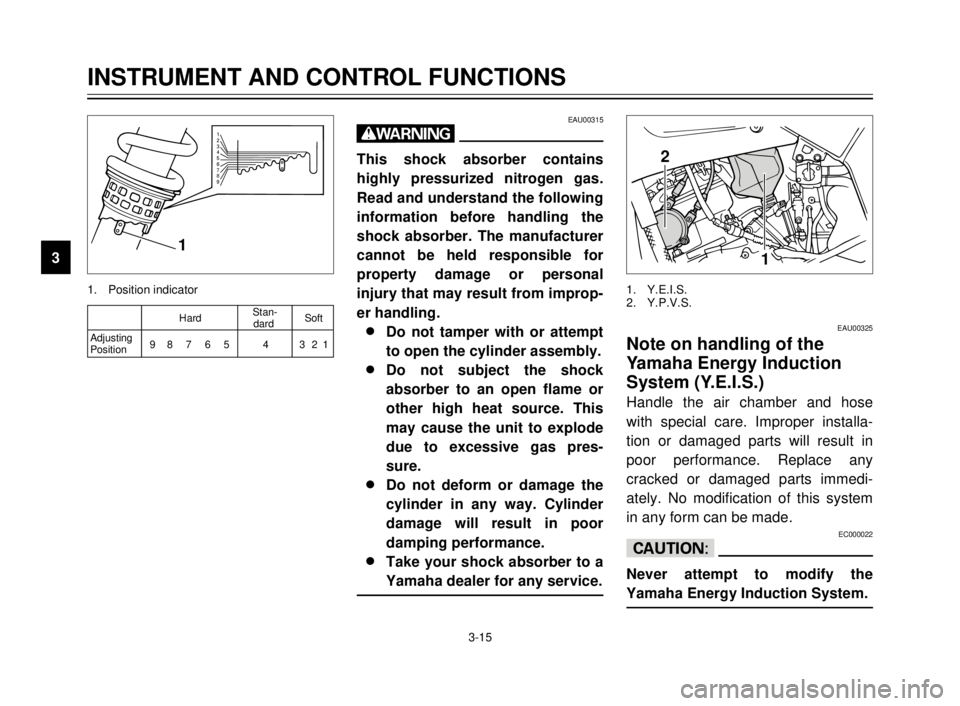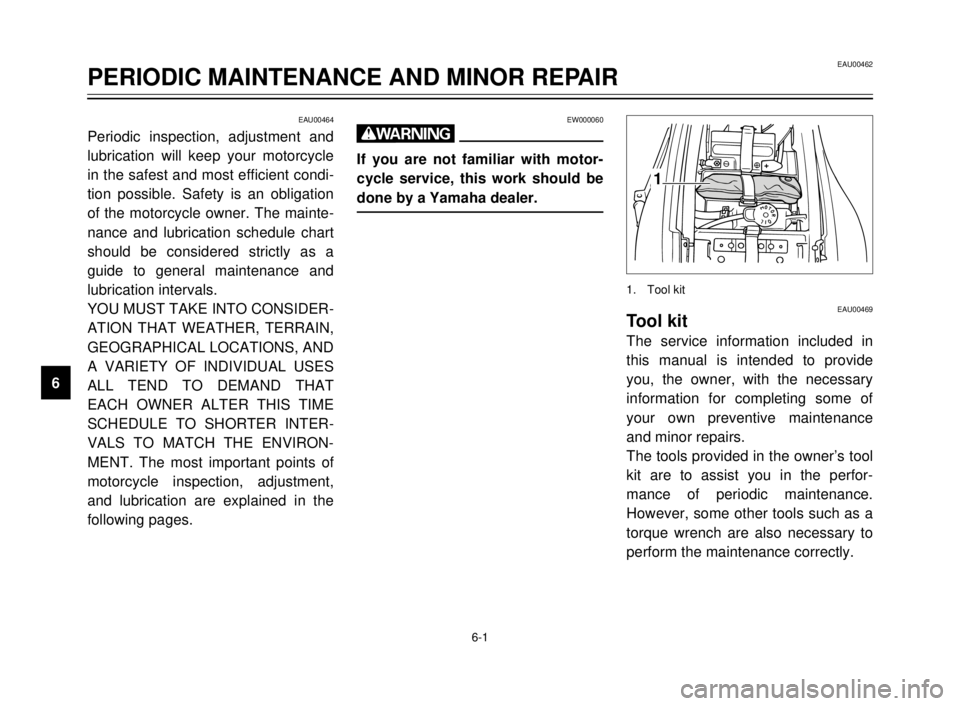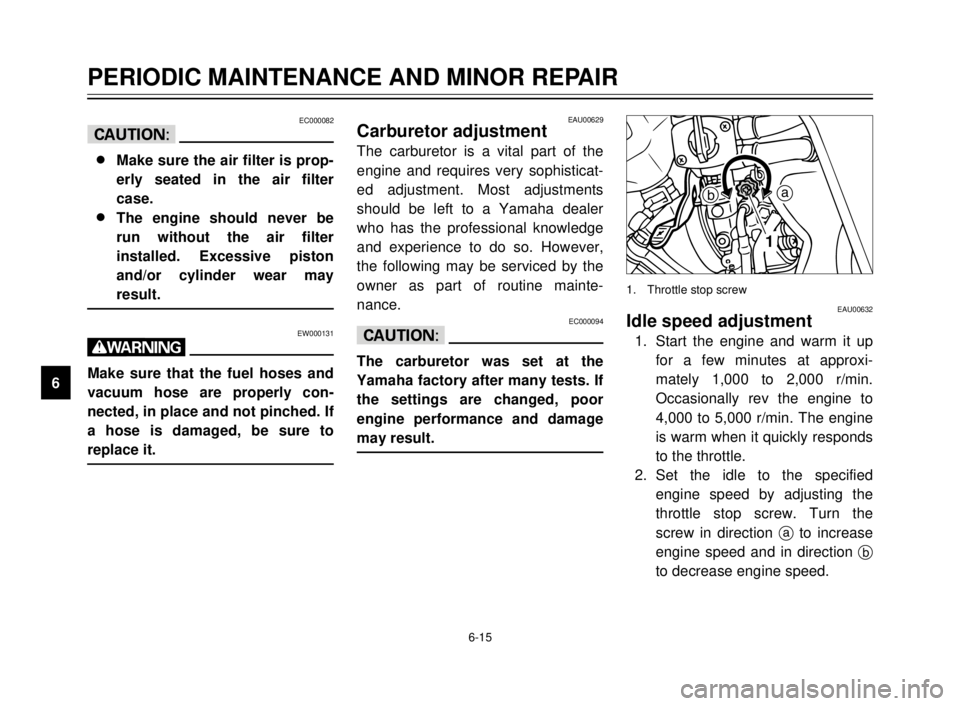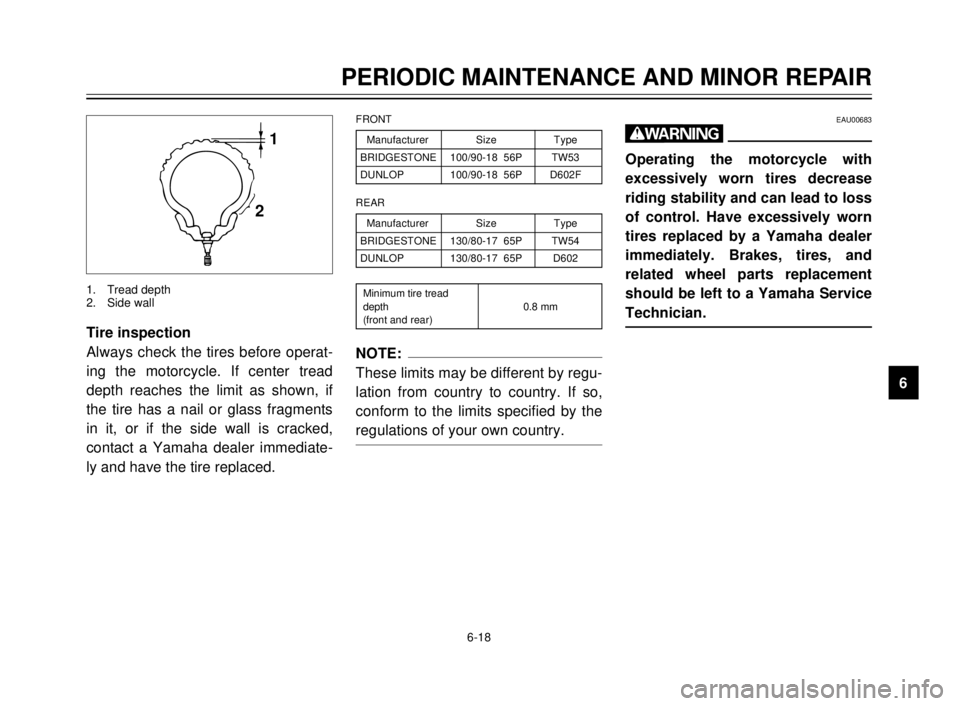2000 YAMAHA TDR 125 service
[x] Cancel search: servicePage 30 of 104

3-15
1
2
3
4
5
6
7
8
9
1
2
1
1. Position indicator1. Y.E.I.S.
2. Y.P.V.S.
EAU00315
w
This shock absorber contains
highly pressurized nitrogen gas.
Read and understand the following
information before handling the
shock absorber. The manufacturer
cannot be held responsible for
property damage or personal
injury that may result from improp-
er handling.
8 8
Do not tamper with or attempt
to open the cylinder assembly.
8 8
Do not subject the shock
absorber to an open flame or
other high heat source. This
may cause the unit to explode
due to excessive gas pres-
sure.
8 8
Do not deform or damage the
cylinder in any way. Cylinder
damage will result in poor
damping performance.
8 8
Take your shock absorber to a
Yamaha dealer for any service.
EAU00325
Note on handling of the
Yamaha Energy Induction
System (Y.E.I.S.)
Handle the air chamber and hose
with special care. Improper installa-
tion or damaged parts will result in
poor performance. Replace any
cracked or damaged parts immedi-
ately. No modification of this system
in any form can be made.
EC000022
cC
Never attempt to modify the
Yamaha Energy Induction System.
INSTRUMENT AND CONTROL FUNCTIONS
1
2
3
4
5
6
7
8
9
HardStan-
Softdard
Adjusting
98 7 6 5 4 321
Position
5AE-9-E3 (ENG) 4/11/0 11:06 AM Page 28
Page 46 of 104

6-1
EAU00464
Periodic inspection, adjustment and
lubrication will keep your motorcycle
in the safest and most efficient condi-
tion possible. Safety is an obligation
of the motorcycle owner. The mainte-
nance and lubrication schedule chart
should be considered strictly as a
guide to general maintenance and
lubrication intervals.
YOU MUST TAKE INTO CONSIDER-
ATION THAT WEATHER, TERRAIN,
GEOGRAPHICAL LOCATIONS, AND
A VARIETY OF INDIVIDUAL USES
ALL TEND TO DEMAND THAT
EACH OWNER ALTER THIS TIME
SCHEDULE TO SHORTER INTER-
VALS TO MATCH THE ENVIRON-
MENT. The most important points of
motorcycle inspection, adjustment,
and lubrication are explained in the
following pages.
EW000060
w
If you are not familiar with motor-
cycle service, this work should be
done by a Yamaha dealer.
EAU00462
PERIODIC MAINTENANCE AND MINOR REPAIR
1
2
3
4
5
6
7
8
9
1
EAU00469Tool kit
The service information included in
this manual is intended to provide
you, the owner, with the necessary
information for completing some of
your own preventive maintenance
and minor repairs.
The tools provided in the owner’s tool
kit are to assist you in the perfor-
mance of periodic maintenance.
However, some other tools such as a
torque wrench are also necessary to
perform the maintenance correctly.
1. Tool kit
5AE-9-E3 (ENG) 4/11/0 11:06 AM Page 44
Page 47 of 104

6-2
NOTE:
If you do not have necessary tools
required during a service operation,
take your motorcycle to a Yamaha
dealer for service.
EW000063
w
Modifications to this motorcycle
not approved by Yamaha may
cause loss of performance, and
render it unsafe for use. Consult a
Yamaha dealer before attempting
any changes.
PERIODIC MAINTENANCE AND MINOR REPAIR
1
2
3
4
5
6
7
8
9
5AE-9-E3 (ENG) 4/11/0 11:06 AM Page 45
Page 50 of 104

6-5
PERIODIC MAINTENANCE AND MINOR REPAIR
6
7
8
9
EVERY
6,000 km 12,000 km
No.
ITEM CHECKS AND MAINTENANCE JOBS
Initialor or
(1,000 km)6 months 12 months
(Whichever (Whichever
comes first) comes first)
9Check operation.
20 * Autolube pump9Correct if necessary.ÖÖÖ
9Bleed if necessary.
9Check oil level and vehicle for oil leakage.
21 Transmission oil9Correct accordingly.
ÖÖÖ
9Change oil at initial 1,000 km and thereafter every
24,000 km or 24 months (whichever comes first).
9Check coolant level and vehicle for coolant leakage.
22 * Cooling system9Correct if necessary.
ÖÖ
9Change coolant every 24,000 km or 24 months (whichever
comes first).
* Since these items require special tools, data and technical skills, they should be serviced by a Yamaha dealer.EAU02970
NOTE
8The air filter needs more frequent service if you are riding in unusually wet or dusty areas.
8Hydraulic brake system
9When disassembling the master cylinder or caliper, always replace the brake fluid. Check the brake fluid level
regularly and fill as required.
9Replace the oil seals on the inner parts of the master cylinder and caliper every two years.
9Replace the brake hoses every four years or if cracked or damaged.
5AE-9-E3 (ENG) 4/11/0 11:06 AM Page 48
Page 60 of 104

6-15
PERIODIC MAINTENANCE AND MINOR REPAIR
1
2
3
4
5
6
7
8
9
EC000082
cC
8
8
Make sure the air filter is prop-
erly seated in the air filter
case.
8 8
The engine should never be
run without the air filter
installed. Excessive piston
and/or cylinder wear may
result.
EW000131
w
Make sure that the fuel hoses and
vacuum hose are properly con-
nected, in place and not pinched. If
a hose is damaged, be sure to
replace it.
EAU00629Carburetor adjustment
The carburetor is a vital part of the
engine and requires very sophisticat-
ed adjustment. Most adjustments
should be left to a Yamaha dealer
who has the professional knowledge
and experience to do so. However,
the following may be serviced by the
owner as part of routine mainte-
nance.
EC000094
cC
The carburetor was set at the
Yamaha factory after many tests. If
the settings are changed, poor
engine performance and damage
may result.
ba
1
EAU00632Idle speed adjustment
1. Start the engine and warm it up
for a few minutes at approxi-
mately 1,000 to 2,000 r/min.
Occasionally rev the engine to
4,000 to 5,000 r/min. The engine
is warm when it quickly responds
to the throttle.
2. Set the idle to the specified
engine speed by adjusting the
throttle stop screw. Turn the
screw in direction ato increase
engine speed and in direction b
to decrease engine speed.
1. Throttle stop screw
5AE-9-E3 (ENG) 4/11/0 11:06 AM Page 58
Page 62 of 104

6-17
PERIODIC MAINTENANCE AND MINOR REPAIR
1
2
3
4
5
6
7
8
9
EAU00647Tires
To ensure maximum performance,
long service, and safe operation, note
the following:
Tire air pressure
Always check and adjust the tire
pressure before operating the motor-
cycle.
EW000082
w
Tire inflation pressure should be
checked and adjusted when the
temperature of the tire equals the
ambient air temperature. Tire infla-
tion pressure must be adjusted
according to total weight of cargo,
rider, passenger, and accessories
(fairing, saddlebags, etc. if
approved for this model), and vehi-
cle speed.
* Load is the total weight of cargo, rider, passenger
and accessories. Maximum load*180 kg
179 kg (CH, A)
Cold tire pressure Front Rear
175 kPa 200 kPa
Up to 90 kg load* (1.75 kg/cm
2, (2.00 kg/cm2,1.75 bar) 2.00 bar)
90 kg load ~175 kPa 225 kPa
Maximum load*(1.75 kg/cm
2, (2.25 kg/cm2,
1.75 bar) 2.25 bar)
EW000083
w
Proper loading of your motorcycle
is important for several character-
istics of your motorcycle, such as
handling, braking, performance
and safety. Do not carry loosely
packed items that can shift.
Securely pack your heaviest items
close to the center of the motorcy-
cle, and distribute the weight even-
ly from side to side. Properly
adjust the suspension for your
load, and check the condition and
pressure of your tires. NEVER
OVERLOAD YOUR MOTORCYCLE.
Make sure the total weight of the
cargo, rider, passenger, and
accessories (fairing, saddlebags,
etc. if approved for this model)
does not exceed the maximum
load of the motorcycle. Operation
of an overloaded motorcycle could
cause tire damage, an accident, or
even injury.
5AE-9-E3 (ENG) 4/11/0 11:06 AM Page 60
Page 63 of 104

6-18
PERIODIC MAINTENANCE AND MINOR REPAIR
1
2
3
4
5
6
7
8
9 Tire inspection
Always check the tires before operat-
ing the motorcycle. If center tread
depth reaches the limit as shown, if
the tire has a nail or glass fragments
in it, or if the side wall is cracked,
contact a Yamaha dealer immediate-
ly and have the tire replaced.
1
2
1. Tread depth
2. Side wall
NOTE:
These limits may be different by regu-
lation from country to country. If so,
conform to the limits specified by the
regulations of your own country.
Manufacturer Size Type
BRIDGESTONE 100/90-18 56P TW53
DUNLOP 100/90-18 56P D602F
FRONT
Manufacturer Size Type
BRIDGESTONE 130/80-17 65P TW54
DUNLOP 130/80-17 65P D602
REAR
Minimum tire tread
depth 0.8 mm
(front and rear)
EAU00683
w
Operating the motorcycle with
excessively worn tires decrease
riding stability and can lead to loss
of control. Have excessively worn
tires replaced by a Yamaha dealer
immediately. Brakes, tires, and
related wheel parts replacement
should be left to a Yamaha Service
Technician.
5AE-9-E3 (ENG) 4/11/0 11:06 AM Page 61
Page 64 of 104

6-19
PERIODIC MAINTENANCE AND MINOR REPAIR
1
2
3
4
5
6
7
8
9
EAU00687Wheels
To ensure maximum performance,
long service, and safe operation, note
the following:
8Always inspect the wheels
before a ride. Check for cracks,
bends, or warpage of the wheels.
If any abnormal condition exists
in a wheel, consult a Yamaha
dealer. Do not attempt even
small repairs to the wheel. If a
wheel is deformed or cracked, it
must be replaced.
8Tires and wheels should be bal-
anced whenever either one is
changed or replaced. Failure to
have a wheel balanced can
result in poor performance,
adverse handling characteristics,
and shortened tire life.
8Ride at moderate speeds after
changing a tire since the tire sur-
face must first be broken in for it
to develop its optimal character-
istics.
a
b12 3
EAU00694
Clutch lever free play
adjustment
The clutch lever free play should be
adjusted to 10 ~ 15 mm.
1. Loosen the locknut at the clutch
lever.
2. Turn the adjusting bolt at the
clutch lever in directionato
increase free play or in direction b
to decrease free play.
3. Tighten the locknut at the clutch
lever.
If the specified free play cannot
be obtained, proceed with the
following steps.
1. Locknut
2. Adjusting bolt
3. Free play
b
a
12
4. Loosen the locknut at the clutch
lever.
5. Turn the adjusting bolt at the
clutch lever in directionato
loosen the cable.
6. Loosen the locknut at the
crankcase side.
7. Turn the adjusting nut at the
crankcase in directionato
increase free play or in direction b
to decrease free play.
8. Tighten the locknut at the
crankcase and the clutch lever.
1. Locknut
2. Adjusting nut
5AE-9-E3 (ENG) 4/11/0 11:06 AM Page 62